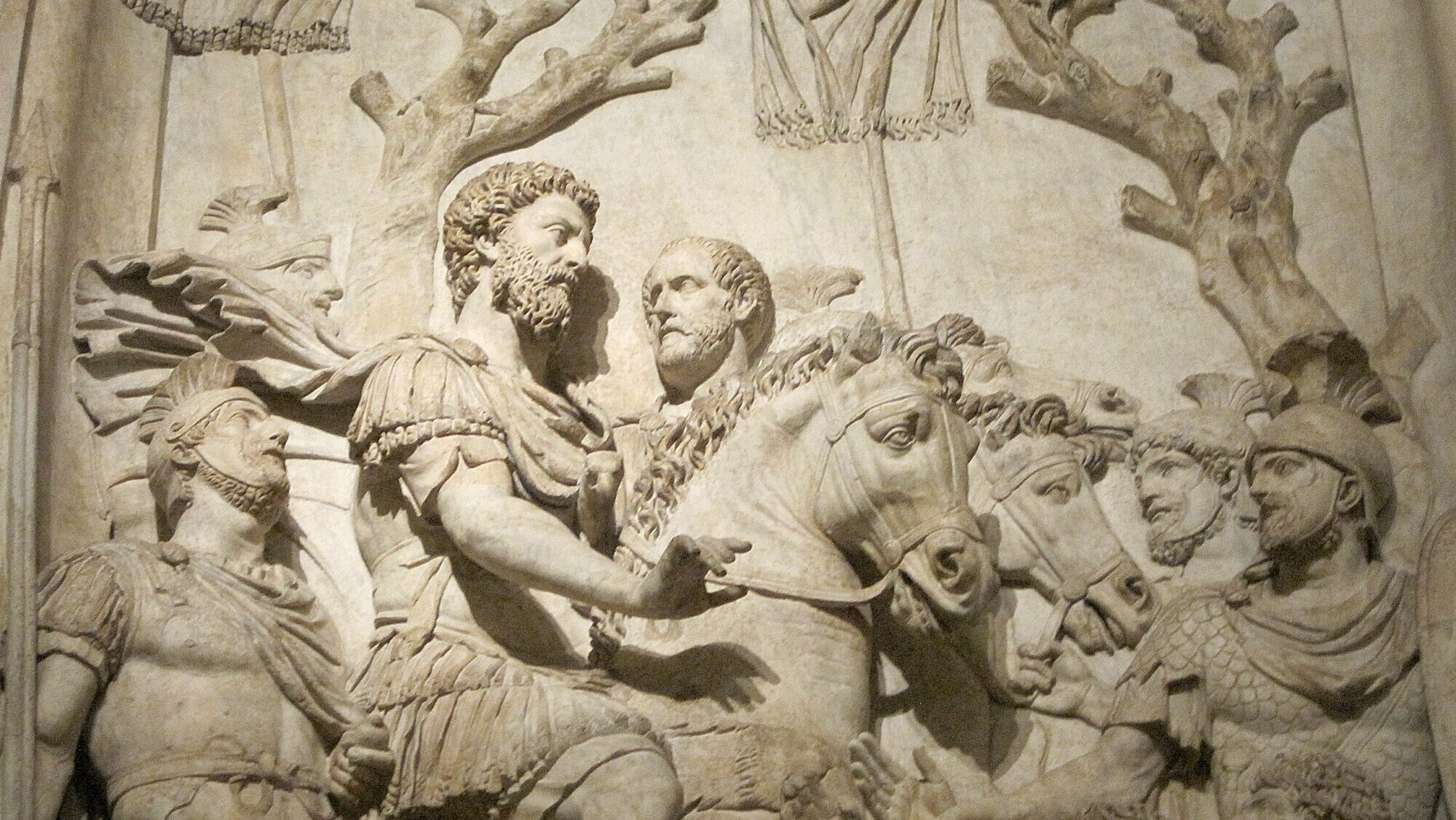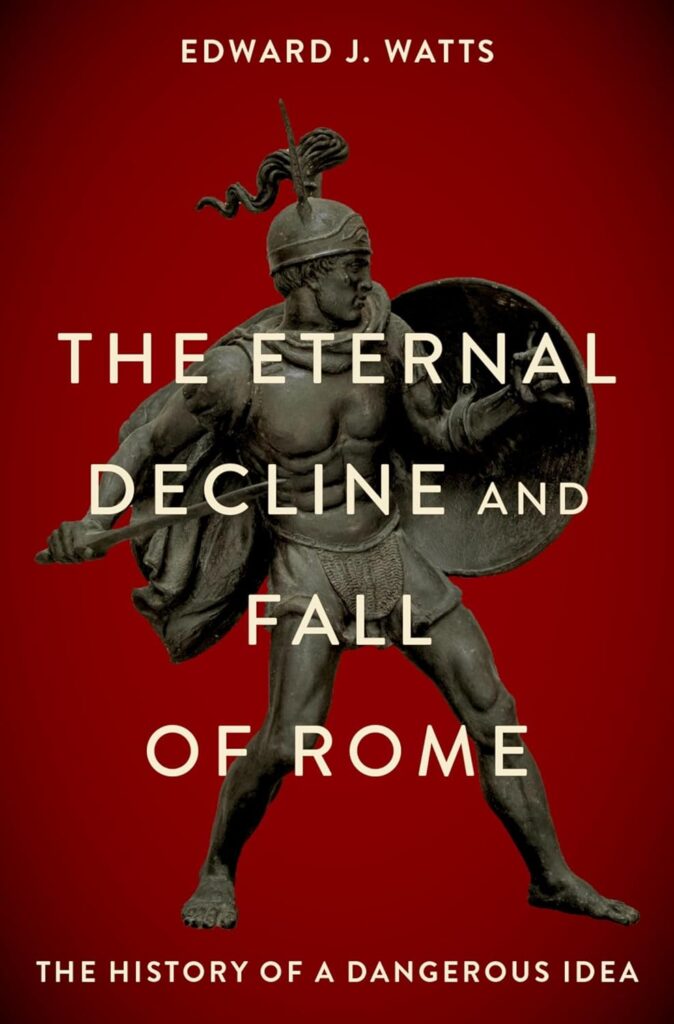
Relief from honorary monument to Marcus Aurelius representing the submission of the Germans (detail), photo by Jean-Pol Grandmont, CC-BY-SA-3.0.

One of the hallmarks of Ron DeSantis’ presidential campaign was encapsulated in his phrase “decline is a choice.” DeSantis’ comment presupposes that America (and perhaps the wider West) is in a state of decline, echoing the Trumpian phrase, “make America great again,” which is itself an echo of earlier mottos used by Republican figures such as Ronald Reagan. These phrases presupposed that America was in a state of decline during both the Obama and Carter administrations. Such language infuriates the political Left as well as some establishment conservatives. The view that America—at least since the Johnson administration—is in a state of decline is an implied condemnation of the progressive policies that have shaped contemporary America. For many conservatives, such a view is self-evident. However, there are many in contemporary America who have benefited from progressive policies. Naturally, they have a different opinion.
The slogans of DeSantis and Trump inevitably conjure the image of the decline and fall of the Roman Empire, which is popularly viewed as having collapsed due to uncontrolled immigration, bad economic policies, and moral deterioration. In his new work, The Eternal Decline and Fall of Rome, UC San Diego history professor Edward J. Watts attempts to defuse the notion that the decline of Rome can be attributed to a single event or cause. Watts presents a fascinating and multilayered historical narrative, demonstrating his immense erudition, but some readers may object to his conclusions.
Watts places his book firmly in conversation with the contemporary world, and thus it has a polemic edge that may be objectionable to some conservative readers. Watts states that he first developed the idea for the book in conversation with another scholar at the 2019 meeting of the Society for Classical Studies. He and another scholar noted that many right-wing figures were comparing Germanic migration and the fall of Rome, in the 5th century, to large-scale immigration and the decline of the West in the 21st century. The Eternal Decline and Fall of Rome begins in what could be called a ‘deductive manner,’ in which conservative figures are shown to be incontestably wrong when they compare the alleged decline of America to Rome. Such a method seeks to argue that conservatives are largely ignorant of history and are merely utilizing it to serve ideological methods.
Watts begins his book with Donald Trump’s January 20, 2017 “American Carnage” speech, which presented an apocalyptic vision of the United States as being in a profound state of decline. Watts argues that when Trump and others like him, such as Santiago Abascal of Spain’s VOX Party and Rodrigo Duterte of the Philippines, describe their countries as being in state of decline and in need of strong executive action to fix their homelands, it is a sign that these politicians have “few supporting facts” to make their arguments. Watt’s statement is very contentious: there is a great quantity of data showing that the United States and wider West are experiencing a state of decline, which parallels the decline of earlier empires such as Rome and Spain. Again, Watt’s argument seems to rest on the idea that conservative and populist figures are unintelligent and oblivious to past and present realities.
Watts does make a strong case that Roman decline has served as a rhetorical example for those who seek power. Moreover, those who used the rhetoric of decline often caused tremendous harm to Rome, and what is presented as a ‘restoration of tradition’ can often be an innovation. Watts further argues that Rome did not always see itself in decline; instead, it presented itself as a resilient survivor of tragedies and misfortune—a view Watts shares in what is one of the strong points of his book. Watts notes that, in AD 165, a smallpox outbreak began in the Roman Empire. This smallpox outbreak, which became known as the ‘Antonine Plague,’ was so destructive that it caused the cessation of military campaigns and frustrated the workings of the Roman political machine. In response to this plague, Marcus Aurelius replaced the Roman population with migrants, slaves, and gladiators. This seems to be Watt’s hopeful perspective: that whatever difficulties America is having, a good leader will work toward positive measures to repair America just as Marcus Aurelius did for Rome.
Watts further notes that Rome (from its Republican days to its afterlife as the Byzantine Empire) has nearly always experienced what could be called ‘declines.’ Plautus’ play of 190 BC, Trinummus (The Three Coins), ridicules Romans who fret about moral decline, attesting to sensibilities that Watts notes were present in the 190s and 180s as Rome grew in wealth and luxury. Those who argued for restraint often pointed to earlier times in which restrained and disciplined Romans fought back Hannibal’s incursion into Italy. The final victory against Hannibal, as Watts notes, was won by Scipio Africanus, who defeated the Carthaginians in Spain and North Africa. Scipio’s triumphant return ushered in a new age of Roman prosperity and even decadence—Watts points to Roman dinner parties in the 180s that lasted for days.
One of the primary opponents of Rome’s new wealth was Marcus Porcius Cato, a rhetorically gifted consul who took aim at what he saw as the decline of Roman virtue. Cato famously attacked the integration of Greek culture into Rome, even going so far as to claim that the Roman Empire would fall due to the corrosive effects of Greek literature. In hindsight, Cato’s attack on Greek culture seems foolish in light of the benefits Rome gained from Greek culture. Watt’s point seems to be to compare the ancient Romans (who ‘wrongly’ objected to Greek philosophy and literature) to contemporary Westerners (who object to the changes to their countries wrought by mass immigration).
Cato’s critique of Roman material decadence, however, had more weight to it in as much as it created a significant wealth gap between rich and poor in Rome, which is not unlike the contemporary gap between rich and poor in America. In response to the suffering of the Roman poor, the Tribune Tiberius Gracchus rose in revolt in 146 BC. Watts holds that Tiberius’ description of the suffering of the Roman poor was false, but it had the rhetorical effect of upsetting Romans who longed for better times. Tiberius was thus able to garner support and overturn the objections of his fellow tribune, Octavius, before using both legal means as well as street violence to drive Octavius out of Rome. Tiberius then undertook a series of violations of the Roman constitution, before he was himself killed by a mob led by his cousin, Scipio Nasica, in 133 BC.
Watts is likely referencing the January 6 protests in his narrative of early Roman history. Indeed, the January 6 protest is mentioned in Watt’s updated epilogue. Watts compares the populist rhetoric surrounding that event to the Byzantine wars against Persia, the looting of Constantinople by Crusaders in 1204, and Charles V’s attack on Tunis. Such comparisons may seem hyperbolic, to say the least.
Watt’s book is well-written and it demonstrates the work of a classical scholar at the top of his game. Moreover, he makes an admirable argument about the need for a positive American leader akin to Marcus Aurelius. However, at times, he undermines his thesis by demonstrating how many world civilizations have been saved by the strongmen Watts condemns in figures like Trump and other populists. Moreover, his depiction of populist demagogues using selective readings of history in order to advance their interests could equally be applied to left-wing figures who have incited violence with their misreadings of world history. Perhaps the best approach to history is humbly allowing history to speak on its own terms, to escape the narrow lens of ideology.